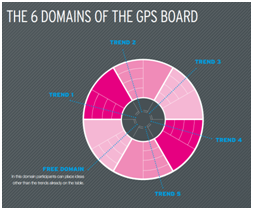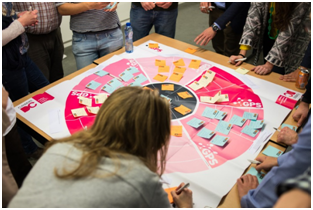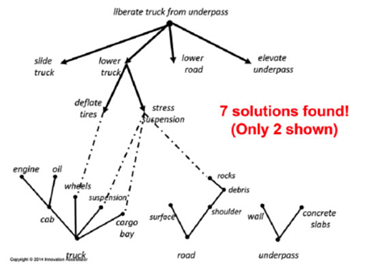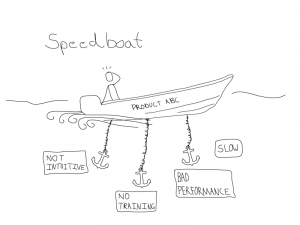Have you ever had brainstorm workshops that didn’t really have any workable output? Or did you ever feel that some people didn’t bring the input you expected them to?
Research shows that the classic way of holding brainstorm sessions isn’t optimal for bringing the best and most innovative solutions to the table.
At AE we offer alternative techniques for optimal output in which every person is comfortable enough to give the necessary input.
People interrupting each other and not letting them express ideas;
The social pressure that each member is under while brainstorming in group;
Group members that are not interested, or just plain lazy.
A study of 3,215 people showed that these are the three main reasons why a standard brainstorm session doesn’t give the expected output. Especially social pressure slows down productivity and makes people feel uncomfortable. Saying something ‘stupid’ or ‘unrealistic’ is the biggest fear of many members in a brainstorm workshop. Another complaint is that extroverts always outweigh the introverts. This again can be related to social pressure, but also to the fact that not everyone gets the chance to express their ideas.
We try to eliminate these drawbacks by using one of the following techniques:
- GPS-Brainstormkit: Many ideas in a short time, anonymity, no discussions
- Brainswarm: 1 problem looked at by top-down thinkers AND solution minded people
- Brainwriting: No need for a meeting room --> Brainstorming from a distance
- Speedboat: To identify pain points and work from there
These four techniques also have a high fun-factor to keep everyone interested and motivated. Obviously, there are many more techniques out there, but these are the ones we've gotten the best results from.
GPS-brainstormkit
This technique is created by Flanders DC and enables you to find your way when you’re lost or stuck, like a real GPS does. In the digital age there are so many things heading our way and it gets harder and harder to find a clear road to your destination. With this tool you’ll get a lot of ideas very quickly without going into any discussions, eliminating the social pressure.
The tool is basically a circle divided into six domains or pieces of a pie. Every piece represents a trend around a general problem or situation, except for the sixth one, which is a free domain. For every domain, a maximum of two attendees will start the idea generation process by writing ideas on post-its, placing them on their piece of the pie. In the first round, attendees have 12 minutes to do this. Then they move to the next piece and have 10 minutes, and so on. Keep in mind that there can not be a limit on creativity. Even ideas that are not at all realizable have a place in this workshop.


After the session, a short back-and-forth among the participants can be held, but that's not mandatory. The moderators can consolidate the ideas and choose a few to work on. Feedback on the progress to attendees of the session is key to keep interest high for a next session.
Pros:
+ Many ideas in a short period
+ No social pressure
+ Free Domain
Cons:
- Processing all of the ideas
Brainswarming
With Brainswarming we need teams consisting of all members of the organization and preferably some external people as well. First off, your team needs to identify a goal (and sub goals) that it wants to reach with this session. Then you need to find the resources that could help to reach this goal (see example below). After identifying the resources and some basic ideas on how to reach the goal, the time has come to connect the dots. Team members can add post-its with ideas or new resources.
This way, they can visualize how resources can grow towards reaching the goal or how to move from the sub goals to resources. A clear advantage of this technique is that it offers a platform for solution-minded people as well as for top-down thinkers. The session works best when everyone works silently and can build on the ideas of others. After the workshop there is room for a small discussion and selection of ideas.

Pros:
+ Both top-down thinkers and solution-minded people
+ No social pressure
+ Team effort
Cons:
- Only for specific cases/issues
Brainwriting
In many situations it is hard to gather the required people in one room to perform an elaborate brainstorm workshop. For these situations, brainwriting (also known as the 6-3-5 method) was invented.
In this technique, we need to define a clear statement of a problem or goal. This statement is then communicated to the participants (preferably a group of +/- 6 people), who each write 3 ideas. Next, they’ll pass their ideas to the next participant who continues on the previous person’s ideas and so on. The advantages of this method are that we don’t need everyone in the same room, no discussion is needed (a clear pro for introverts) and that every idea is the source for a new one.
Pros:
+ Can be done from a distance
+ Inspiration from previous ideas
+ Collaborating without speaking
Cons:
- Hard to follow-up (when done from a distance)
- Can be ignored if the team is not in the same room
Speedboat
The idea of this method is to identify issues or difficulties concerning a product, problem, …
You start by drawing a speedboat on a whiteboard or flip chart and attach some anchors to the boat. In the session members can put post-its around the anchors to show what elements are holding the attendees back concerning the product or problem. When identifying the pains, find some ‘quick wins’ and identify a strategy to tackle the bigger issues. End the session with a discussion of things that will put ‘wind in the sails’ of your boat (convert it to a sail boat).
Pros:
+ Visualization
+ Identify issues in a fun way
+ Gets people to understand each other
Cons:
- Can get negative
- Hard to keep discussions until the end. Ex: "What do you mean when you write ..."
Conclusion
Every technique has its advantages and restrictions. It’s up to the workshop organizer to identify the best tool for the job. Keep in mind these key takeaways and you'll find that your future brainstorm sessions will be much smoother:
- Warming-up is essential to be creative
- Keep it fun
- Always end on a positive note
- Make sure everyone can follow up after the session
- Don’t underestimate the power of post-its
Are you interested in using one of these techniques, but don't know where to start? Or do you have issues generating and deploying great ideas in general? Get in touch and we'll gladly help you out!
Image credits: Flanders DC, AE, Tony McCaffrey, Online Business Systems.





.png)